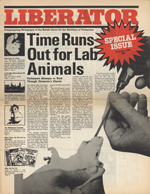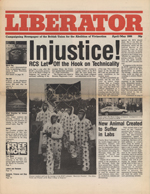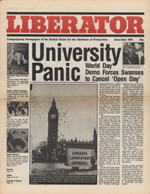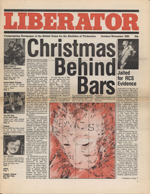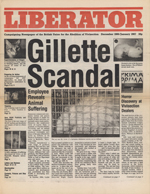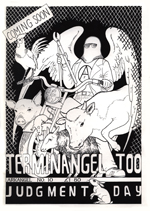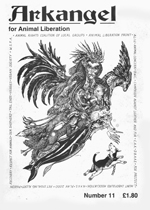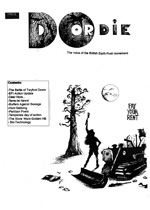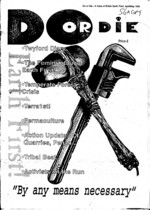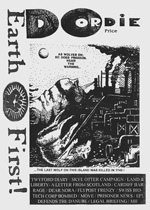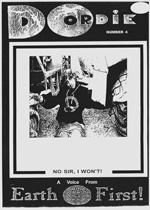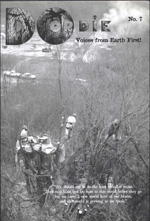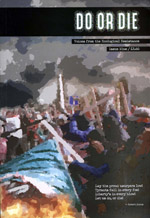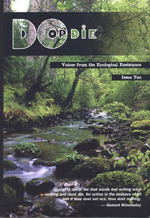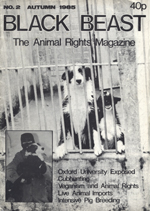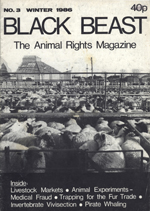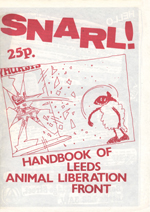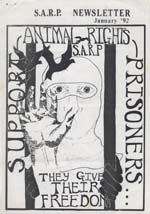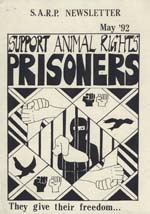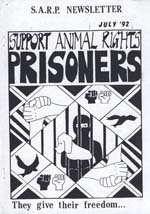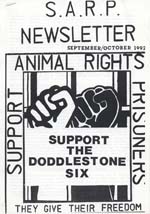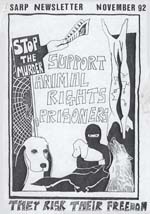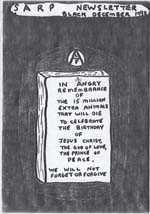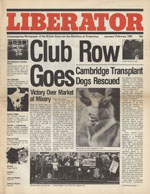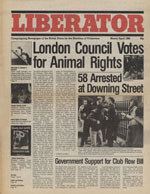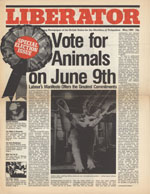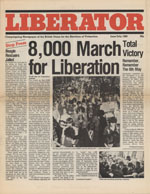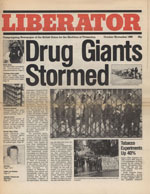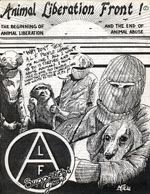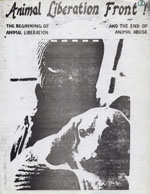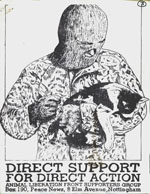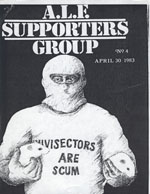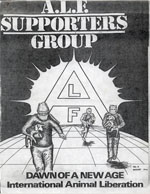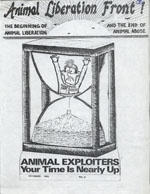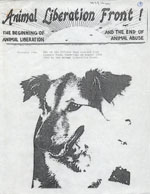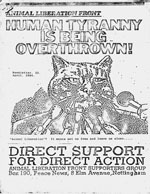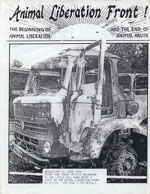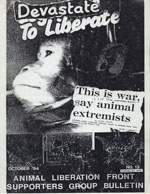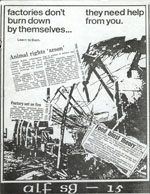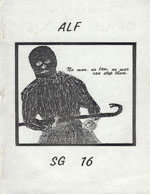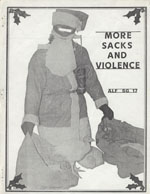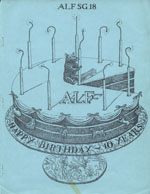The Archives
-
BUAV Liberator, Most Popular
BUAV Liberator 1986
10.15.14 | PermalinkBUAV Liberator (1986. London, England)
“Although the BUAV as a limited company can only organize legal activity, we aim to complement and support direct action whenever possible.” BUAV editorial, April-May 1986
Frequent readers of the site will be aware that TALON’s volunteers are big fans of the BUAV Liberator. Not only do its old pulp pages bleed with animal lib history, but the politics represented by BUAV at that time were among the most progressive (and occasionally radical) of any major national non-profit working for non-humans.
During this era the British Union to Abolish Vivisection supported any direct action which did not include pre-meditated violence towards a human, and proudly advocated a broad array of strategies and tactics. From letter writing to sabotage, legislation to arson, the BUAV gave coverage to nearly all of the activism in England at the time- and that is only a small part of what makes these papers so great.
Year after year, each volume of the Liberator gives us clues as to the mood within the movement. In 1986 for example, we see a somber tone set over the movement as the Liberation League’s began to fold, the government passed legislation expanding vivisection, and dozens of activists began prison sentences over lab raids. This blow to activist morale in 1986 was perhaps most visible in the actions of Robert Blackman, a young man who entered the Colchester cattle market and self immolated to protest the sell of living beings. His mother later said that “He gave his life because he thought the cruelty would never stop.”
Interestingly, 1986 was also a year filled with inspiring actions for animals. Issue after issue details labs shut down, vivisectors ending their careers, a dramatic rise in veganism and vegetarianism among the general public, and non-humans having their first taste of freedom. It is only within the context of the meteoric rise of animal rights in the earlier part of the 1980s could this year be seen as any kind of a failure. Indeed, if the level of activism in these issues were to occur today morale would sky rocket and great breakthroughs could be made- and all of us should take that as a challenge!
…
-
Arkangel, Periodicals
Arkangel #10-11
07.03.14 | PermalinkArkangel #10-11 (1993-1994. London, England.)
The early 1990s were a tumultuous time for the movement in England. Hunters began hiring professional security services to beat and harass saboteurs, the violence became so extreme that when Tom Worby was murdered by a hunt masters vehicle, the hunters nearby laughed and mocked his death. The hopefulness of the 1980s was fading away, and campaigners were becoming more hardened, which in turn led to a decline in public support as groups like the Justice Department began sending out small mail bombs. Many organizations were mired in infighting over strategy and issues of class and race. And then there was the problem of repression. Scotland Yard’s Animal Rights National Index had gathered detailed profiles on over 21,000 animal liberationists by 1990, and their spying on the movement was only set to intensify.
Through it all a dedicated core of individuals forged ahead and took animals from places of abuse, educated others about the plight of non-humans, and spread the message of compassionate action across oceans and artificial borders. Arkangel tells the story, and we are happy to continue our posting of the complete set here on TALON.
…
-
Do or Die, Most Popular, Periodicals
Do or Die – The Complete Set!
04.09.14 | PermalinkDo Or Die #1-10 (1993-2003, Brighton, England.)
A few years ago a friend asked me if I had a complete set of Do or Die, the British Earth First! publication that inspired and incited eco-warriors throughout the 1990s and early 2000s. At one time I did have them, but they had long since been stolen by a Joint Terrorism Task Force.
After a brief discussion, we decided that Do or Die was too important to fade into obscurity. We began tracking down each issue, and decided that while we were at it we ought to archive some other publications as well. That effort is how this web site began, and now, thanks to 56a infoshop of South London and Tim @ NEDS Northampton, we can finally share the very rare issue #2. This completes our collection, and our original mission as well.
When read as a set, Do or Die is a chronicle of people from across the globe counter-striking capitalism, ecocide, and the state. Each issue is better than the last, but more importantly, each page is a spark licking at the fuse of the bomb that is your heart. Once lit, you’ll know that these pages are not mere history, but a reminder that we can explode onto the world stage like the fighters before us have. Do or die, now is the time to rise.
…
-
Periodicals
Black Beast #2-3
02.07.14 | PermalinkBLACK BEAST – Issues 2 & 3 (1985-1986, Oxford, UK)
Taking it’s name from the french term “bête noire,” Black Beast ran for 3 issues before changing it’s title to Turning Point.
Black Beast covered all aspects of animal liberation protest and resistance, from sign holding demonstrations, to lab raids, alongside investigations into various abuses of non-humans. It’s politics were pro-direct action, but anti-militarism, and editorials inside criticized groups like the Animal Rights Militia. Articles were published without bylines, and every aspect of the magazine was anonymous. This made it an attractive forum for groups like the Central Animal Liberation League, who sent in a first hand account of the infamous Park Farm raid at Oxford that freed 32 dogs. One issue even contains an interview with a pre-off-the-deep-end Gary Francione detailing his support for the Animal Liberation Front!
The magazine was well written, nicely produced, and also very rare! TALON is seeking a copy of issue #1. If you can share one with us, please contact us HERE.
…
-
One-off publications
SNARL! Handbook of the Leeds A.L.F.
11.12.13 | PermalinkSNARL! Handbook Of Leeds ALF (1985. Leeds, England)
One of the great things about punk music is also one of the worst things about it: anyone can do it. On the one hand this encourages kids to destroy the adulation of rockstars and to make music (as well as zines, clothes, art, etc) themselves. That accessibility has brought us the voices of people we never would have otherwise heard, which is wonderful. On the other hand, punk doesn’t exist in a vacuum, it came into being in a culture afflicted with bias and brutality, patriarchy, capitalism, and so on. Those elements are ingrained in many of the creators of punk and are, at times, reflected in the works they produce. Those messages are then carried on to those who consume that media.
It isn’t hard to make the leap from an analysis of punk to an analysis of leaderless resistance. Without a hierarchy or organized recruiting mechanism, the A.L.F. has often spread through the same means as punk rock- DIY media, the passion and anger of youth, and at times, sensationalized mainstream media stories. People have heard the call and picked and up the banner, acting on their own initiative to make change. The downside, of course, is that without a training component that goes beyond a few words in a zine about security culture, these newly active saboteurs aren’t always left with the skill set needed to safely or effectively undertake underground actions. They may end up making their own publications which repeat the mistakes of the ones they first read, and these will be passed on to the consumers of that media.
If I were 16 years old and living in Leeds in 1985, I would have loved SNARL. It speaks from a place of youthful (and righteous) rebelliousness, and although the tone can be a little dogmatic, nearly everything else about the “handbook” is just plain cool. I laughed out loud to see license plates, makes and models of undercover police vehicles listed, and was encouraged to see the inclusion of human liberation struggles. That said, the young folks who made this zine were reproducing some of the worst aspects of other publications from the era as far as security and theatrical militancy goes.
SNARL is an interesting product of it’s time, written and distributed by well meaning, hard-fighting folks who no doubt had the best interest of non-humans in their hearts. That said, I hope readers at the time were cautious in following the advice it contained, because much of it was outright dangerous. Looking at the prisoner listings from this period, that doesn’t seem to be the case.
…
-
Campaign newsletters, Periodicals
Support Animal Rights Prisoners Newsletters: Year Two
07.30.13 | PermalinkS.A.R.P. Newsletter #6-11 (1992 – Northampton, England)
One of the big frustrations of working on the TALON site is that the materials we archive contain so much information it becomes difficult to organize and contextualize it all. Our posting of the Barry Horne SARP newsletter revival has made this sense of frustration more distinct than ever.
1992 was an eventful year for the movement: Mike Hill was murdered by hunter Alan Summersgill, the Doddlestone six were arrested protesting that murder, in North America Darren Thurston was arrested, Ronnie Lee was released, Kieth Mann was on remand and just about to escape from prison… This is just the tip of the iceberg as far as the significant events that took place over twelve long months twenty one years passed. We could spend pages discussing how these incidents shaped the future, how recent revelations about police informants in the UK have changed our understanding of old arrests, and so on. Unfortunately there is no time to pull at all of these strings- but the SARP newsletters certainly will provide inquisitive readers with many threads of their own to pull. From details of Operation Fox to “Laugh Along with the ALF,” each newsletter if filled with intriguing bits of our collective history.
…
-
BUAV Liberator, Periodicals
BUAV Liberator – 1983
07.16.13 | PermalinkBUAV Liberator (1983. London, England)
The British Union for the Abolition of Vivisection was first established in 1898 by the Irish feminist Frances Power Cobbe. In its long history it has rarely been effective as a fighting force for non-humans, but every so often the organization has a flash of brilliance. In the 1980s, sparked to greater militancy by an explosion of youth activism against vivisection, one of these “flashes” became a conflagration that lasted more than five years.
After shedding their corporate image for something with a little more edge, the BUAV’s publication, “Liberator” became the most important publication during England’s rise of animal lib militancy. While the legislative and educational work of the Union continued, they also incorporated support for direct action. The results were spectacular. Mainstream acceptance of the underground increased, protests grew in size, more people began directly saving non-humans from places of abuse, the grassroots expanded, and unity across the tactical spectrum meant less infighting and more progress for all parties involved.
As always, marriages between moderates and radicals are unstable, and like many others this one ended in a bitter divorce. The BUAV kicked Ronnie Lee’s ALF Press Office out of their building, the SG denounced BUAV as do-nothing liberals, and direct action became harder to support as groups like ARM started sending postal bombs. Still, it was a productive relationship while it lasted, and these newspapers provide an interesting look into just what a national organization for animals can accomplish.
…
-
Books
Rage and Reason
06.24.13 | PermalinkRage And Reason (First edition publication date and location unknown. AK Press edition: 1998, San Francisco, CA)
Despite assurances from Ingrid Newkirk and Steven Seagal to the contrary, this book just isn’t all that good. Marketed as an animal rights revenge novel (complete with former Special Forces commandos skinning furriers) Rage and Reason was banned in some countries upon its initial release. The hype over these bans fueled great curiosity among those of us in North America who were having a difficult time obtaining a copy. In 1998 AK Press produced a new edition which immediately landed with a dull thud in the movement. We all bought and read R&R at the same time, and a few days later one could feel the collective disappointment.
I will not ruin the “surprise” for those of you have have yet to read the book, but… well, shit. Let’s just say that if you find yourself enjoying the story, brace yourself for the cop out coming in the final pages. Also: non-vegan protagonists in an animal liberation murder story? Yeah, they’ve got the dedication to risk life sentences for beheading CEO’s of agri-businesses, but they just can’t stop eating yogurt! Pfft!
…
-
Do or Die, Periodicals
Do or Die #9
03.27.13 | PermalinkDo or Die #9 (2000, Brighton, England.)
We always write the same thing when we post an issue of Do or Die, so this time we will spare you the superlatives. This issue has worldwide ecological news, human freedom struggles, non-human direct action, and a radical history of football alongside a little bit of humor and many inspiring images. A must read, so click below and get to it!
…
-
Most Popular, Periodicals, The SG (original 80s volume)
The ALF Supporters Group Newsletter – The complete original set!
03.04.13 | PermalinkThe ALF Supporters Group Newsletter #1-19 (1982-1986. Nottingham / London, England)
When this archive project was founded two years ago, a list was made of the ten publications that we “had to have.” Number one was a complete set of the first volume of “The SG.” This was a tall order, and we knew it. First off, the Animal Liberation Front Supporters Group must be one of the most raided entities in England, and its members were frequently raided themselves! The result was that many copies of the magazine ended up in police custody both before and after distribution, never to be seen again. Second, it was a relatively old newsletter, and since the first issues were mimeographed on cheap paper, finding intact copies was going to be difficult. We persevered though, and now these rare pieces of movement history are preserved digitally and online for everyone to read and learn from.
Started by Dave Nicholls in 1982, the ALF Supporters Group was an effort to do two things: 1.) To raise funds for people arrested for animal related direct actions. 2.) To create a broader base of support for the Animal Liberation Front inside the movement. Both goals were met quickly. Within two weeks of their founding, the Supporters Group hit the number of members they had set as their long term goal. Through direct donations, memberships, fundraising events, and sales of merchandise, the SG was able to contribute towards the sizable legal costs of activists being arrested across England.
The newsletter itself went through varying degrees of quality in writing, layout, and value to the movement. The early days of the Nicholls run may have had a drab interior, but the hand illustrated covers were sometimes gorgeous, and the rhetoric had not yet strayed into the more-militant-than-thou nonsense which came later. Eventually the writing would border on the cultish, but there is scarcely an issue of the magazine that doesn’t have some redeeming value. When read critically and as a whole body of work, this magazine follows the rise and spread of underground action for animals across the globe, illustrates the value of coalition building, and provides solid examples of extremism to be avoided through coverage of groups like the Animal Rights Militia. It also provides many historical details found nowhere else!
“The SG” has gone through several incarnations since British Law enforcement shut this one down in 1986. (While carrying out the investigation for the notorious Sheffield trial that sent Ronnie Lee to prison for 10 years, the police raided the SG and charged it’s editors with incitement. Everything published by the SG afterwords had to be run past a lawyer first, but this didn’t stop further raids, arrests, and convictions of those involved in the newsletter.) It is still being published today, copies can be ordered from www.alfsg.org.uk.
Finally, an excellent analysis and critique of the SG and the rise of England’s “Cult of Militancy” can be found in the book Against All Odds, available here at the Talon Conspiracy.
…
